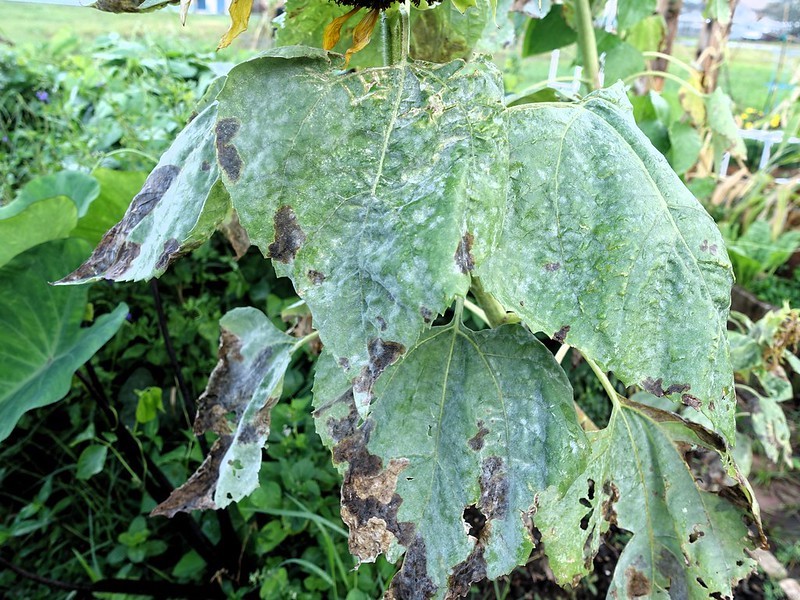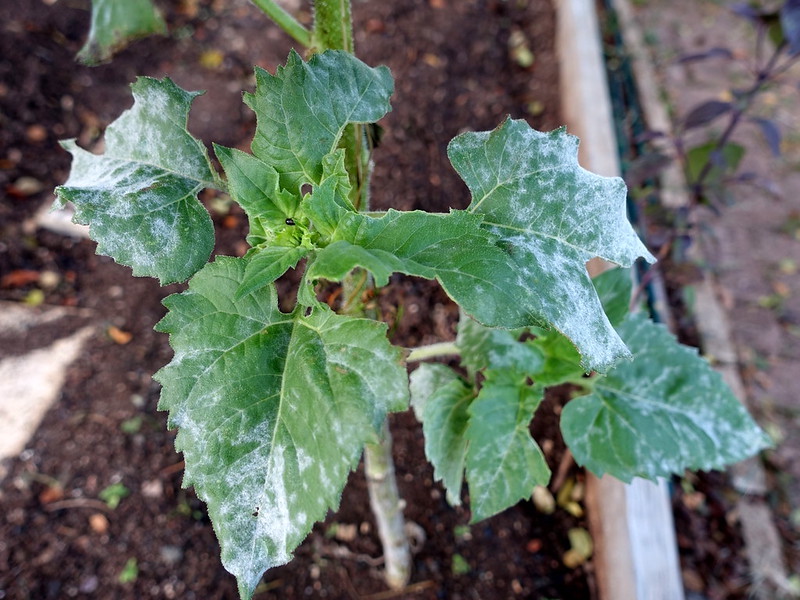Sunflowers are easy plants to grow that add a summertime look and feel to a space. Bright yellow flowers bloom during the summer and fall, and some cultivars produce edible seeds. While sunflowers are known as tall plants with large flowers, various smaller cultivars have a bushy appearance but still produce stunning flowers. Sunflower plants can contract diseases that impact the plant’s health and growth. These diseases can be fungal, bacterial, or viral, but they are all treatable and preventable. Learning to spot the signs of sunflower disease makes it possible to treat the issue or take steps to prevent it immediately.
- Sunflower Rust
- Powdery Mildew on Sunflowers
- Downy Mildew on Sunflowers
- Sunflower Leaf Spots

Sunflower Rust
Rust is a fungal disease that mars foliage. This disease does not impact the health of sunflower plants, but it is distracting visually. Rust is likely to emerge when airflow is restricted by plant debris on the ground and close plantings. Infected sunflower plants can experience leaf drop and stunted growth.
Identifying Rust
Rust can be identified on sunflowers as lesions or spots that appear on the leaves. The spots can be red, orange, yellow, or brown, and they break open, releasing rust-colored powdery spores.
Treating Rust
Treat rust by removing infected leaves, which is an ongoing process. Prevent rust by removing plant debris at the end of the season and giving plants adequate space when planting. Rust is less likely to be an issue when there is sufficient airflow, so don’t crowd plants.
Sunflower Powdery Mildew
Powdery mildew is a fungus that impacts a variety of plants, including sunflowers. In extreme cases, infected leaves die and fall from the plant. Powdery mildew is more likely to happen in hot, humid conditions.
Identifying Powdery Mildew
The signs of powdery mildew include white patches or spots that form on foliage and stems. Large, broad leaves are usually susceptible to this fungus. Powdery mildew is not fatal but causes stunted growth and leaf loss.

Treating Powdery Mildew
The easiest way to treat powdery mildew is to carefully remove infected leaves when the chalky mildew appears. Removing leaves minimizes the chance of the fungus spreading. Leaf removal can be ongoing. Infected leaves should be destroyed to prevent further spread. When planting, prevent powdery mildew on sunflowers by leaving enough space between the plants. Air circulating around leaves can prevent powdery mildew from developing.
Sunflower Downy Mildew
Downy mildew is a mold that can infect the foliage of sunflower plants. Cramped growing conditions and a lack of airflow cause downy mildew. In extreme cases, infected leaves wilt and die. The resulting leaf loss can stunt growth and causes the plant to look bare.
Identifying Downy Mildew
The first sign of downy mildew is leaves appearing chlorotic or turning yellow. The yellowing is due to a lack of chlorophyll. As the mold develops, it turns into a gray fuzzy growth.
Treating Downy Mildew
Treat sunflowers infected with downy mildew by applying fungicide and carefully removing infected leaves. Destroy the leaves to minimize the spread. It may take several attempts at removing leaves to ensure you get them all. Downy mildew forms on sunflowers when plants are crowded together, and the conditions are damp. When planting, leave adequate space between the sunflowers, especially in areas prone to high humidity.
Sunflower Leaf Spots
Leaf spots are a disease that can impact sunflowers and other plants. The spots can be fungal, bacterial, or viral. Infected leaves ultimately wither and die, which causes stunted growth.
Identifying Leaf Spot
Sunflower leaf spots appear as brown, circular spots on foliage. The spots can vary in size and shape, but the irregularity is part of the identification process.
Treating Leaf Spot
Removing impacted leaves is a quick and easy way to treat sunflower leaf spots. Destroy infected foliage to prevent the spread. Apply a fungicide to treat leaf spots.
Prevent leaf spots on sunflowers by watering plants early in the morning. When watering, try to water the ground around the plant and keep the foliage as dry as possible. Ideally, the foliage will dry out during the day, reducing the risk of leaf spots forming. Healthy sunflower plants are less likely to suffer from leaf spots, so keep up with watering and fertilizing to help the plants thrive.
Sunflower Disease Chart
|
Disease |
Identifying |
Treating |
|
Rust |
Spots of foliage |
Prune/discard foliage |
|
Powdery Mildew |
White spots on leaves |
Proper air circulation |
|
Downy Mildew |
Chlorotic leaves that develop a gray, fuzzy growth |
Water in the morning and provide adequate air circulation |
|
Leaf Spots |
Dark spots on leaves |
Fungicides & air circulation |
Sources: "Sunflower (Helianthus)." The Connecticut Agricultural Experiment Station. portal.ct.gov
 |
Author Alison Cotsonas - Published 05-01-2023 |
